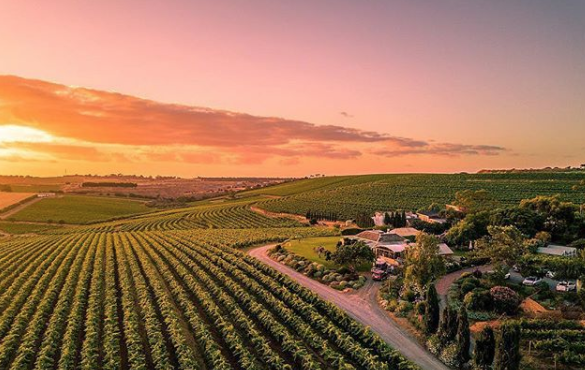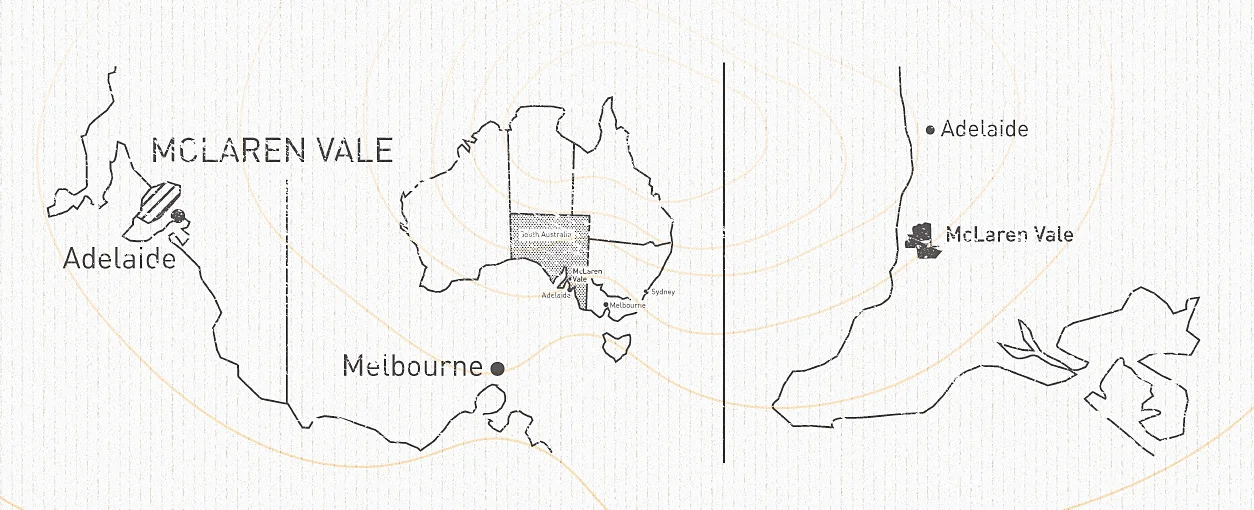Vineyard
This is the page description.
Our new Home
“Welcome To ORGANIC HILL Vineyard
36 Twentyeight Road, McLaren Vale”
Nestled in the heart of the McLaren Vale, South Australia’s oldest premium wine region wine region, lays the ’36 Twentyeight Road’ vineyard - the new home of Organic Hill Wines, our family and soon-to-be Cellar Door.
The property spans a compact five acres with four under vine.
There are 2.2 acres of 30-year old low-yield Shiraz and 1.8 acres or old-vine Grenache dating back to a post-war planting in 1946, which our viticulturist tells us are quite possibly the oldest surviving blocks of Grenache vines in ‘the Vale’.
With our devotion to organic principles, we believe they are destined to produce outstanding, super premium fruit for our inaugural 2019 vintage.
The property was originally owned and established by the Rayner family one of McLaren Vale’s pioneering vignerons.
Like the small clutch of other famous Rayner established vineyards in the region (growing some of the finest Shiraz fruit in Australia), the vineyard is planted in deep, classic McLaren Vale red-brown sandy loam. Hallowed ground that has been farmed according to ‘organic principles’ for the past decade and that we are currently developing to full NASAA Certification.
Additional to the vines we have six large Avocado trees, an ages-old fig tree, an apple tree and the obligatory lemon tree. And as the new fencing goes in we will add sheep, chickens and maybe some ducks and geese to naturally keep down the grass, weeds and bugs in the vineyard rows, while providing natural fertiliser and nutrients.
Alongside our Avocado Trees we are also planting an extensive herb and vegetable garden to provide for our future cellar door café.
The future looks rosy and we can’t wait to celebrate our first organic ’36 Twentyeight Road’ vintage under the Organic Hill banner.
McLaren Vale – the premium place for organic wines
Welcome to McLaren Vale, South Australia.
Only 45 minutes south of Adelaide in South Australia, McLaren Vale is home to sustainable winegrowing, world-class wines and culinary experiences, as well as pristine natural attractions and unparalleled tourism offerings.
South Australia's viticultural origins began in McLaren Vale and our region's Mediterranean climate continues to drive our region's wine style and diverse food culture.
Best known for Shiraz, McLaren Vale also excels in the production of ultra-premium Grenache and Cabernet. Mediterranean varieties such as Fiano, Vermentino, Tempranillo and Sangiovese are also very well suited climatically and provide wine lovers with yet another layer of discovery.
Our region's 30 kilometres of breath-taking coastline and ranges define McLaren Vale's boundaries, and the distinct landscapes and environment within.
McLaren Vale's collaborative and generous nature, unique combination of world-class wines and produce - both on the farm and on the plate - with a beach lifestyle, ensure that our region truly offers a unique and welcoming experience
“McLaren Vale is the birthplace of the South Australian wine industry and home to some of the world’s oldest grape vines.”
McLaren Vale's extensive natural and cultural heritage spans over thousands of years of traditional ownership by the Kaurna people and recently, has been shaped by European colonisation.
The colony of South Australia was founded in 1836 and McLaren Vale was established two years after following a survey conducted by John McLaren.
John Reynell and Thomas Hardy planted grape vines in 1838 and the Seaview and Hardy wineries were in operation as early as 1850.
At that time, McLaren Vale wineries made heavy, dry table wines in the style required by the bulk wine merchants and exporters of the 19th century. By the turn of the 20th century there was a shift towards making fortified wines.
Between 1920 and 1930, exports trebled and finally, after World War II, local sales increased. In the 1950s, several McLaren Vale wineries began bottling small parcels of selected wines and established cellar door tastings and sales.
In the same period, many Italian migrants settled in McLaren Vale and introduced olive and olive oil production. More recently, the production of almonds, cheese, milk and cream have added to the rich food tapestry of our region.
It was not until the 1970s that table wine grew in popularity and within the same decade, over 25 new wineries were established in our region which specialised in the production of distinctive Shiraz, Cabernet and Grenache.
Today, McLaren Vale is host to more than 80 cellar doors and our region's wines and their makers continue to receive awards and major trophies at the most prestigious wine shows in the world.
McLaren Vale has produced wine since 1838.
With more than 178 years of experience, our region’s reputation is strongly established in South Australia’s and Australia’s winemaking origins.
Today, our region remains Phylloxera free and is known for innovative viticultural and winemaking techniques and an international reputation for producing the ‘trilogy’ of Australian reds: Shiraz, Cabernet Sauvignon and Grenache.
Of our region’s 7,412 hectares of area under vine, 54% of our plantings are dedicated to Shiraz, however our region also excels in producing exceptional Mediterranean alternative red and white varieties including Fiano, Vermentino, Barbera, Montepulciano, Nero d’Avola and Tempranillo.
McLaren Vale is also home to a significant number of boutique brewers and passionate distillers and our region’s reputation continues to grow steadily.
Discover more!
Harvest or ‘vintage’ in McLaren Vale can begin as early as the beginning of February in early ripening varieties such as Chardonnay and is usually complete by the end of April.
Adequate temperatures reliably ripen all varieties in almost all areas of our region. Rainfall and heat are the two major climatic factors which can impact upon harvest conditions.
Typically, the southernmost point of our region will ripen first with harvest dates occurring later travelling in a north-easterly direction from Aldinga through to Blewitt Springs.
GEOLOGY AND SOIL
McLaren Vale is one of the most geologically diverse regions in the world. More than 40 unique geologies are present in our region and vary in age from 15,000 years to over 550 million years.
The Geology of the McLaren Vale Wine Region map was developed as a result of decades of diligent investigation by curious geological scholars and provides a key to the complex, constantly unfolding links between geology and modern wine flavours.
Prepared by Geologist’s Bill Fairburn, Jeff Olliver and Wolfgang Preiss of Primary Industries and Resources South Australia (PIRSA), together with wine writer Philip White, the map was published in 2010, titled ‘Geology of the McLaren Vale Wine Region’.
Ongoing study of our region’s geology provides a key to the complex, constantly unfolding links between geology and regional wine varietals and flavours, whilst the map continues to assists viticulturists in appropriate planting.
There is a wide variety of soil types, a reflection of the varied terrain; red brown sandy loams, grey brown loamy sands with yellow clay subsoils interspersed with lime, distinctly sandy soils and patches of red or black friable loams are all to be found.
As the long-standing and intensive viticulture of our region attests, the soils and geography of McLaren Vale are very well suited to premium wine grape growing.
McLaren Vale is at the forefront of best practice in terms of soil surveying and as such this diversity is well respected, with a dedicated group of our region’s growers, wine makers and geographers forming a committee to explore these differences in greater detail.
CLIMATE
M McLaren Vale’s climate is Mediterranean and characterised by warm summers, moderate winters, winter-dominated rainfall, low relative humidity and relatively high evaporation.
McLaren Vale is roughly triangular in shape and bordered on three sides. Adelaide to the north, the Mt Lofty Ranges to the east and south, and the Gulf St Vincent to the west.
The proximity of Mt Lofty and the Gulf of St Vincent play a very important role in moderating the climate of our region and are largely responsible for many of the meso and micro climatic differences.
Elevation in our region peaks at 350 metres along the Sellicks foothills and Chandlers Hill, with majority of vineyards located on gently undulating to flat land between 50m and 150m.
Wind is a significant factor within McLaren Vale. There are two distinct and completely separate wind sources within our region: gully winds which blow east-west down through the foothills, and sea breezes blowing south-north up through Gulf St Vincent.
The climatic diversity of McLaren Vale has helped producers successfully embrace Spanish and Italian varieties such as Barbera, Fiano, Tempranillo, Mouvedre and Moscato and explore re-emerging varieties like Viognier, Sangiovese, Zinfandel and Verdelho.
"the finest Organic Vineyards
in the land"
Additional to our home region of McLaren Vale, we partner with established organic growers in the specific sub-regions of Renmark and Barmera in the Riverland – along with the Limestone Coast. And we do that for very good reasons associated with finding the best terroir for organically growing specific varieties.
While South Australia generally is globally recognised as producing world-class wines, the peak body representing the Riverland's wine industry believes the region specifically has all the ingredients to become a world leader in growing fruit for premium winemaking organically, particularly white varieties like Sauvignon Blanc and Pinot Noir.
And we’ve also found the Cabernet and Shiraz fruit from the region has particular characteristics suited to premium Preservative Free winemaking, an art in itself.
Riverland Wine Region executive officer Chris Byrne believes the region's growing conditions are as good as anywhere in the world to produce organic grapes: "We believe there is a real opportunity that because of our very low rate of pest and disease in this region, the Riverland could well and truly lay claim to becoming the organic vineyard of the world."
With our years now of patient experience and experimentation with regional and site selection we can only but agree.











